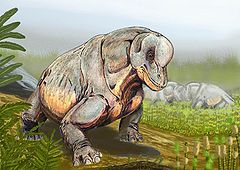| Tapinocephalus Assemblage Zone | |
|---|---|
| Stratigraphic range: Middle Permian to Late Permian[1] | |
 Tapinocephalus atherstonei | |
| Type | Biozone |
| Unit of | Abrahamskraal Formation of the Beaufort Group |
| Underlies | Pristerognathus Assemblage Zone |
| Overlies | Eodicynodon Assemblage Zone |
| Thickness | up to 6,561.68 feet (2,000 m) |
| Location | |
| Region | Northern, Western & Eastern Cape |
| Country | |
| Extent | Karoo Basin |
| Type section | |
| Named for | Tapinocephalus atherstonei |
| Named by | Watson (1914), Keyser & Smith (1977-78), Kitching (1984) |
The Tapinocephalus Assemblage Zone is a tetrapod assemblage zone or biozone which correlates to the middle Abrahamskraal Formation, Adelaide Subgroup of the Beaufort Group, a fossiliferous and geologically important geological Group of the Karoo Supergroup in South Africa. The thickest outcrops, reaching approximately 2,000 metres (6,600 ft), occur from Merweville and Leeu-Gamka in its southernmost exposures, from Sutherland through to Beaufort West where outcrops start to only be found in the south-east, north of Oudshoorn and Willowmore, reaching up to areas south of Graaff-Reinet. Its northernmost exposures occur around the towns Fraserburg and Victoria West. The Tapinocephalus Assemblage Zone is the second biozone of the Beaufort Group.[2][3][4]
The name of the biozone refers to Tapinocephalus atherstonei, a large herbivorous tapinocephalid dinocephalian therapsid. It is characterised by the presence of this dinocephalian species along with the appearance of other advanced tapinocephalid dinocephalians, and the large pareiasaur Bradysaurus baini. It is also the first biozone of the series where the dicynodont, Diictodon feliceps, species first appear.
- ^ Rubidge, B.S.; Kitching, J.W. (2003). "A new burnetiamorph (Therapsida: Biarmosuchia) from the Lower Beaufort Group of South Africa". Palaeontology. 46 (1): 199–210. doi:10.1111/1475-4983.00294.
- ^ Rubidge, B. S. (ed.) 1995b. Biostratigraphy of the Beaufort Group (Karoo Supergroup). South African Committee of Stratigraphy. Biostratigraphic Series 1. Pretoria, Council for Geoscience.
- ^ van der Walt, Merrill; Day, Michael; Rubidge, Bruce; Cooper, Antony; Netterberg, Inge (2010-12-31). "A new GIS-based biozone map of the Beaufort Group (Karoo Supergroup), South Africa". Palaeontologia Africana. 45: 1–6.
- ^ Jirah, Sifelani; Rubidge, Bruce S. (2014-12-01). "Refined stratigraphy of the Middle Permian Abrahamskraal Formation (Beaufort Group) in the southern Karoo Basin". Journal of African Earth Sciences. 100: 121–135. doi:10.1016/j.jafrearsci.2014.06.014. ISSN 1464-343X.